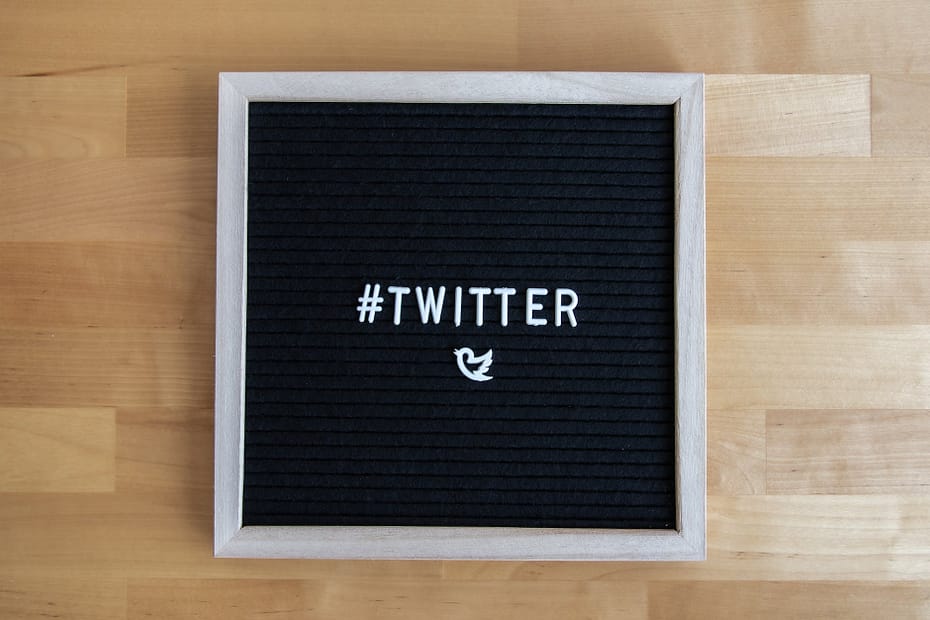There’s a bias I’ve always held against Twitter; that it is a good-for-nothing toxic space. I know that’s harsh but the events that led me to stop using the app in 2021 morphed this idea. All through my absence, I held on to it.
In 2022, I decided to give Twitter another try. I still dislike how it encourages hate and cancel culture, but I’ve realised that Twitter has its uses. Just because I experience something differently does not mean it’ll resonate with others!
How did I come to this realisation? My curiosity led me to research how people experience Twitter and if these experiences affect use-time. I formulated my hypotheses and ran a survey for ten days. I collated the valid responses (44 responses) and analysed the data with Excel, Data Studio, Python and a bit of R. What I found startled me. If you continue reading, you’ll laugh at how far my hypotheses are from reality!
Read more…
- I dived into my process and how I conducted the research in this case study.
- If it interests you check out the code for the hypotheses tests.
Hypotheses
I assumed that Twitter’s toxicity affected the amount of time people spent using it.
My hypotheses:
- The proportion of people whose experience with Twitter’s content is awful will be 45% of the sample.
- The proportion of people whose feelings about Twitter are extremely unhappy will be 45% or more of the sample.
- The experience people have with Twitter and how people feel about Twitter are significantly associated with how people use Twitter.
- There is a significant association between one’s ability to control their Twitter feed and how one feels about Twitter when using it.
Now for the results.
Insights
Most people use Twitter as a source of news, comedy & trends
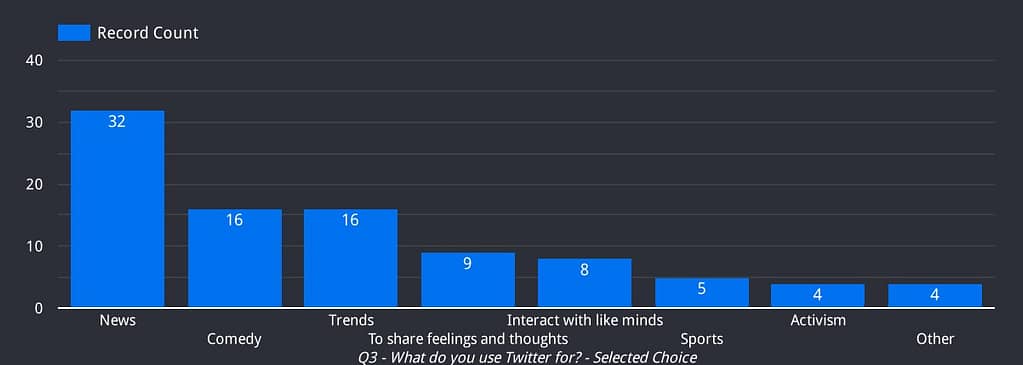
Twitter annoys me, its noisemakers infuriate me but the results from the study made me understand that it is versatile enough to supersede bants, trolling and its essential function of sharing tweets in 260 characters.
Note
The top 3 uses of Twitter are using Twitter as a news source (73%, n = 32), as a source of comedy (37%, n = 16) and to view trends (37%, n = 16).
Besides, during my Twitter break, I was less informed about news and trends.
Thoughts About Twitter: A love-hate relationship
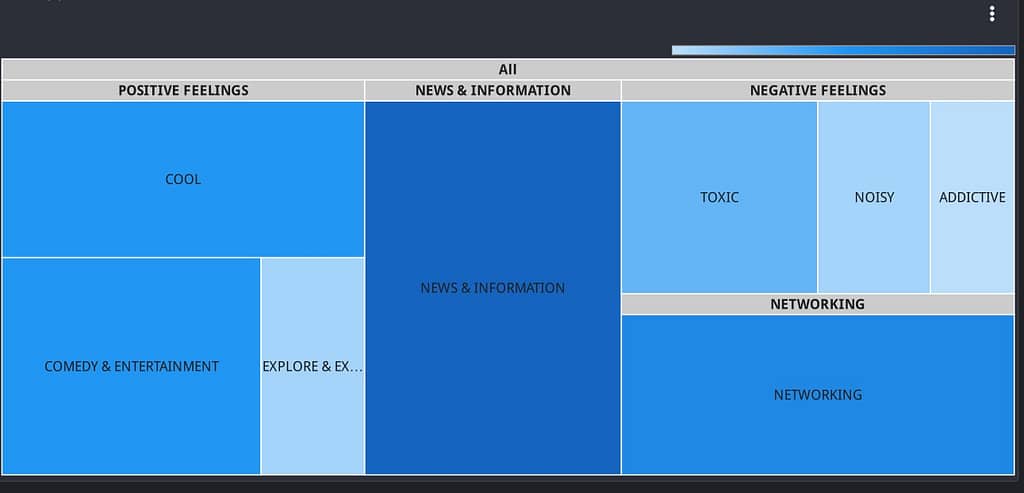
Tweeps are in a love-hate relationship with Twitter. Although love overruns hate. My survey asked participants to tell me what they thought about Twitter.
Note
The responses fell under 4 themes: News and information (n = 17, 39%), Networking (n = 12, 28%), Negative feelings (n = 14, 32%) and positive feelings (n = 24, 55%).
It made sense that Twitter received praise for its ability to provide news and information. For the 32% that expressed negativity about Twitter, they complained about its toxicity (n=7, 16%), addictiveness (n=3, 7%) and noisy nature (n=4, 9%), just like I did.
This quote encapsulates Twitter’s essence 👇🏾
“It is a great avenue to express yourself in what you believe there’s always someone whose thought would align with yours. It is a place for first hand news around the world fake or real we get it anyway. It could be toxic sometimes too”
Anonymous responder
Shocker 1: Good content, positive feelings!

I couldn’t believe that most of my sample found Twitter’s content good. I also did not want to accept that most felt “somewhat happy” while using Twitter! I assumed that 45% of my sample would report Twitter’s content as terrible and would report feeling extremely unhappy when using Twitter. I was wrong.
Shocker!!!
Most ( n= 20, 46%) of the sample think the content is good while only 2 (5%) responders think it is terrible. The p-value between my hypothesised sample and the real sample was 1.52-12 (0.00000000000152%) which means that there is an extremely low chance that my assumptions would ever match the responses.
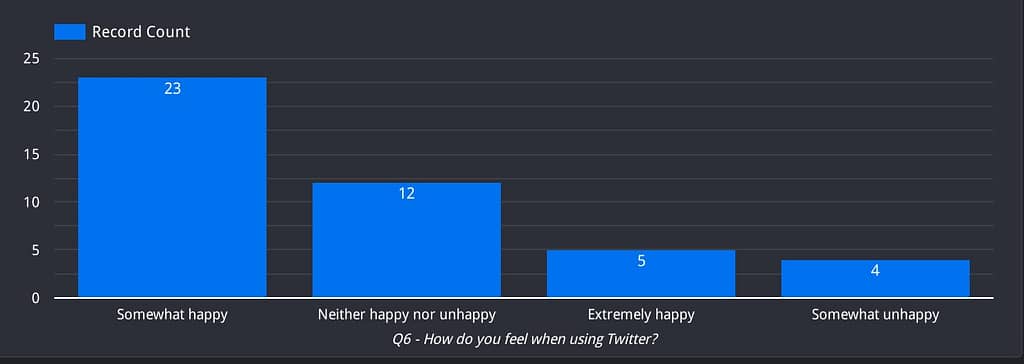
Shocker!!!
Similarly, most (n = 23, 52%) feel somewhat happy when using Twitter. 12 (27%) responders feel neither happy nor sad when using Twitter. A small number (n = 4, 9%) feel somewhat unhappy when using Twitter. No one feels extremely unhappy when using Twitter. It was apparent that my second hypothesis was wrong. This time, my p-value for the chi-square test of good fit was 3.2-15 (0.0000000000000032%). That’s small!
Shocker 2: The chain reaction
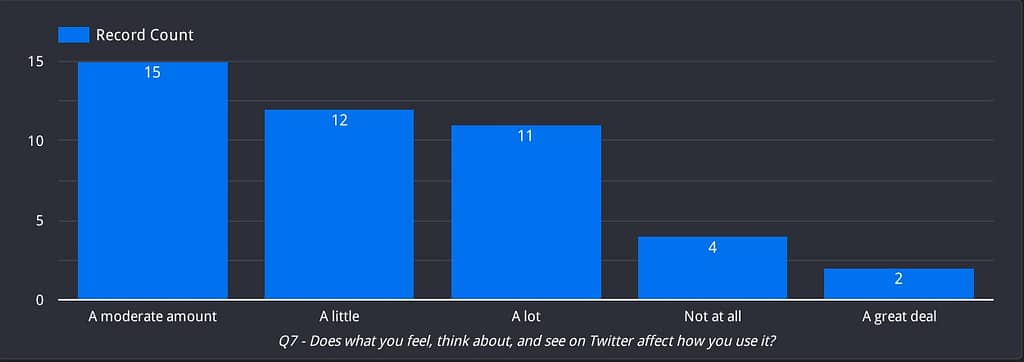
What drives tweeps to use Twitter? What are those factors that influence how they use it? There’s a chain reaction between how people feel about Twitter, what they think about the content and how the former and latter influence their use of Twitter.
Shocker!!!
First, the quality of Twitter’s content is associated (p-value = 6.3-5 (0.000063%) with how people feel about Twitter. Second, how people feel about Twitter is linked (p-value = 0.02 (2%) to how they use Twitter!
Participants who reported positive feelings (extremely and somewhat happy) about Twitter equally reported positive feelings about its content. Those who reported mixed and negative feelings (neither happy nor unhappy and somewhat unhappy) about Twitter felt that Twitter’s content ranged from average to poor.
Moderate control: Insufficient control options
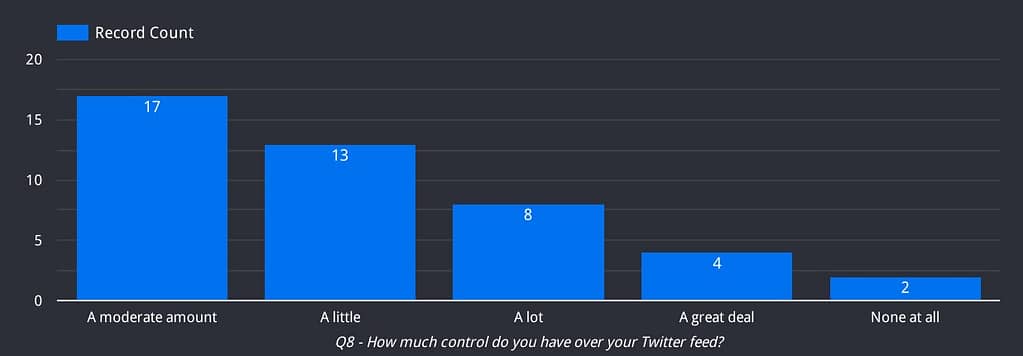
It’s tough to control my Twitter feed. I can’t count the number of times I have stumbled on an irrelevant tweet irrespective of the options available: lists, following and unfollowing people, topics, blocking etc. Twitter bases its algorithm on you and your followers’ interests. The algorithm contributes to the noise.
Note
It turns out that 17 (39%) responders have a moderate amount of control over their Twitter feeds, while 13 (30%) have little control. 35 (80%) responders try to control their feeds by following or unfollowing people, 18 (41%) by blocking and 17 (39%) by muting. Regardless of these options, they do not suffice.
One’s ability to control their feed is related to how they feel when using Twitter
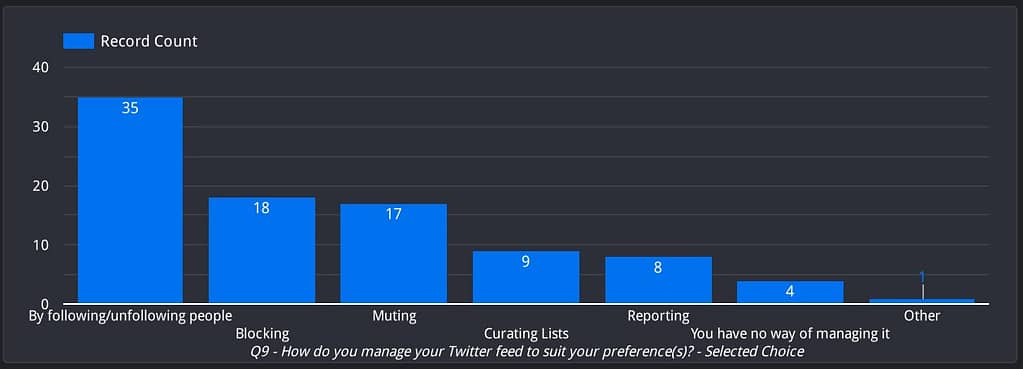
Only 4 (9%) of responders have a great deal of control over their Twitter feeds. Does one’s ability to control their Twitter feed affect how they feel about Twitter? Yes!
Note
I ran a Fisher’s exact test on both variables and it showed a substantial (p-value= 0.02 (2%)) association between the two. Most who feel extremely and somewhat happy about Twitter reported that they have a lot and a moderate amount of control over their Twitter feeds. The control of those who feel neither happy nor sad and somewhat unhappy ranges from a moderate amount to a little.
Recommendations
Give Twitter users more control over their feed!
While Twitter has some features that enable users to control their feeds, it is not enough. Alleviating this might involve making the algorithm more transparent. Twitter needs stronger control options. If Twitter allows users to moderate their content, they can customise their Twitter experience rather than share experiences with followers.
Optimise Twitter for news, networking, comedy & trends
Twitter already has features that optimise the experience for viewing news and articles such as the explore page and recommending topics that interest the user. Recently, Twitter has also tried to improve its networking powers by introducing Twitter spaces. What if Twitter optimised the platform for tweeps with specific needs? For example, if a tweep only needs Twitter for news, they should have access to (only) Twitter for news.
Like most of the sample, I now have a love-hate relationship with Twitter. It has its uses and peeves which can make or mar the overall experience.
Read more…
If you are interested in learning about my process, the whats, hows and whys read the case study.
I enjoyed carrying out this study. The most significant part of it was how I was able to question my assumptions and test them. I have learnt that sometimes (probably most times) my experiences differ from others.
